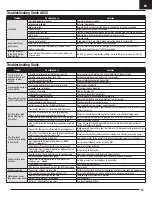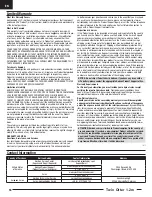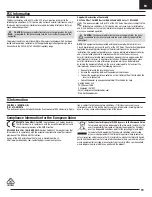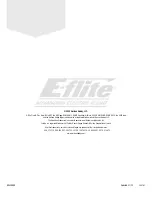
EN
12
Twin Otter 1.2m
Flying Tips and Repairs
Consult local laws and ordinances before choosing a flying location.
Getting Started
Before you fly, range check the radio system. Refer to your specific transmitter in-
struction manual for range test information. When you first connect the battery to the
airplane AS3X will not be active. After advancing the throttle the first time, the AS3X
system will be active and it is normal to see the control surfaces react to aircraft
movement. For your first flights set your transmitter timer or a stopwatch to 5 min-
utes. Adjust your timer for longer or shorter flights once you have flown the model.
Takeoff
Face the aircraft into the wind for takeoff. Set your transmitter to low rates and drop the
flaps to takeoff position (half position). Flaps are not required, but lowering them makes
takeoffs shorter.
Gradually increase the throttle to full, and steer on the ground with rudder as
necessary to keep the aircraft rolling straight. Be aware the nose wheel will become
more sensitive as speed increases. Leave the elevator at neutral and allow the aircraft
to accelerate up to speed on the ground, then pull up gently on the elevator to rotate
for takeoff. When airborne, climb to a comfortable altitude, and return the flaps to the
level position.
Flying
For your first flights climb to a moderate altitude and get comfortable with the aircraft
while the battery is fresh. Get a feel for the aircraft’s low speed performance with the
flaps up and down at a safe altitude (approximately 100 feet or more) before being
required to make your first landing attempt. Land the aircraft when the timer expires.
If at any time the motor power reduces, land the aircraft immediately to recharge the
flight battery. See the Low Voltage Cutoff (LVC) section for more details on maximizing
battery health and run time.
Landing
Plan to land the aircraft into the wind when possible. Fly downwind and turn into
the wind to begin the approach. Lower the throttle and lower the flaps to the
landing position (full down position.) Flaps will make the landing approach steeper
and slower, and allow for a smoother landing. If there is a significant crosswind,
only lower the flaps to the takeoff position (middle position) which will help
maintain speed and better directional control during approach.
During the approach and descent, keep the wings level and the aircraft pointed into
the wind. The angle of attack (the angle between the aircraft’s pitch attitude and the
horizon) should remain consistent and slightly nose high during the decent. With the
angle of attack maintained during the descent, the speed and descent rate is mostly
controlled with small throttle changes. Stay into the throttle to maintain speed and
control during decent until the aircraft is ready to flare. As the airplane descends into
ground effect, fully lower the throttle, pull the nose up more to bleed off airspeed
(flare), and the aircraft will settle on its wheels.
Once on the ground leave the elevator neutral and avoid sharp turns until the plane
has slowed enough to prevent scraping the wingtips.
NOTICE:
If a crash is imminent, reduce the throttle and trim fully. Failure to do so
could result in extra damage to the airframe, as well as damage to the ESC and
motor.
NOTICE:
After any impact, always ensure the receiver is secure in the fuselage.
If you replace the receiver, install the new receiver in the same orientation as the
original receiver or damage may result.
NOTICE:
Crash damage is not covered under warranty.
NOTICE:
When you are finished flying, never leave the aircraft in direct sunlight
or in a hot, enclosed area such as a car. Doing so can damage the aircraft.
Low Voltage Cutoff (LVC)
When a Li-Po battery is discharged too much per cell, it will not hold a charge. The
ESC protects the flight battery from over-discharge using Low Voltage Cutoff (LVC).
Before the battery charge decreases too much, LVC removes power supplied to the
motor. Power to the motor reduces, showing that some battery power is reserved
for flight control and safe landing.
Disconnect and remove the Li-Po battery from the aircraft after use to prevent
trickle discharge. Charge your Li-Po battery to about half capacity before storage.
During storage, make sure the battery charge does not fall below 3V per cell. LVC
does not prevent the battery from over-discharge during storage.
NOTICE:
Repeated flying to LVC will damage the battery.
Tip:
Monitor your aircraft battery’s voltage before and after flying by using a Li-Po
Cell Voltage Checker (SPMXBC100, sold separately).
Oscillation
For most flight maneuvers the aircraft should fly smoothly and normal, but it
is possible in some flight conditions you may see oscillation (the aircraft rocks
back and forth on one axis due to overcontrol). If oscillation occurs, refer to the
Troubleshooting Guide for more information.
Repairs
Thanks to the EPO foam material in this aircraft, repairs to the foam can be made
using virtually any adhesive (hot glue, regular CA, epoxy, etc). When parts are not
repairable, see the Replacement Parts List for ordering by item number. For a listing
of all replacement and optional parts, refer to the list at the end of this manual.
NOTICE:
Use of CA accelerant on your aircraft can damage paint. DO NOT handle
the aircraft until accelerant fully dries.
SAFE Select Flying Tips
When flying in SAFE Select mode the aircraft will return to level flight any time the
aileron and elevator controls are at neutral. Applying aileron or elevator control will
cause the airplane to bank, climb or dive, and the amount the stick is moved will
determine the attitude the airplane flies. Holding full control will push the aircraft to
the pre-determined bank and roll limits but it will not go past those angles.
When flying with SAFE Select it is normal to hold the control stick deflected with
moderate aileron input when flying through a turn. To fly smoothly with SAFE Select
avoid making frequent control changes and don’t attempt to correct for minor
deviations. With SAFE Select, holding deliberate control inputs will command the
aircraft to fly at a specific angle and the model will make all corrections to maintain
that flight attitude.
Return the elevator and aileron controls to neutral before switching from SAFE
Select mode to AS3X mode. If you do not neutralize controls when switching into
AS3X mode, the control inputs used for SAFE Select mode will be excessive for
AS3X mode and the aircraft will react immediately.
Differences between SAFE Select and AS3X modes
This section is generally accurate but does not take into account flight speed,
battery charge status, and many other limiting factors.
• In
SAFE Select mode
the aircraft will self level when the control stick is neutralized.
In
AS3X mode
the aircraft will continue to fly at its present attitude when the
control stick is neutralized.
• In
SAFE Select mode
holding a small amount of control will result in the model
banking or pitching to a moderate angle and remaining at that angle as long as
the control stick doesn’t move.
In
AS3X mode
holding a small amount of control will result in the model con-
tinuing to pitch or roll at a slow rate as long as the control stick doesn’t move.
• In
SAFE Select mode
holding full control will result in the airplane banking or
pitching to the predetermined limits and the aircraft will keep flying at that at-
titude as long as the control stick is fully deflected.
In
AS3X mode
holding full control will result in the aircraft pitching or rolling as
fast as possible, and it will continue to rapidly change attitude as long as the
control stick is fully deflected.






































